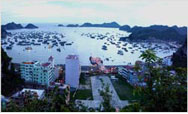You are here » Home » Telling Our Story
Photo & Caption
Clean-up Effort Builds Good Will

| |
Photo: USAID/Suzanne Ross
|
|
Villagers, resettled communities, and local officials work together to establish new recycling and waste disposal practices.
|
The December 2004 tsunami in Southeast Asia left a thick trail of debris along every coastline it struck. The task of cleaning up and removing that debris was enormous. Villagers who had lost family members, businesses, and homes were overwhelmed by the enormous job that lay ahead of them. Some places, particularly areas surrounded by mangroves, were impossible even for bulldozers to reach. Villagers carted away debris from destroyed houses, boats, and buildings by hand to the main road a mile from the village, where trucks finished the job.
At the same time, villagers saw communities of people displaced by the tsunami springing up around them. But these new communities had no systematic waste removal structure in place, and local government resources were fully dedicated to the tsunami debris-removal problem. This situation created some tension between villagers, who spent all day cleaning debris, and displaced communities, who had no resources to develop a waste-removal system. It also posed significant health problems, as garbage collected around living spaces. Something had to be done.
Together, the villagers and displaced people tapped into a USAID program that builds local capacity by involving all stakeholders — villagers, community groups, and local governments — in assessing, designing, implementing, and managing programs to rebuild tsunami-affected areas. With help from the program, the parties reached a consensus — to launch a “clean environment initiative.” Tapping into USAID’s cash-for-work program, they hired a team of 25 to implement the initiative in collaboration with local authorities. The team purchased trash baskets and placed them in residential areas. Pleased with the effort to protect health and maintain a clean tourist-friendly environment, local officials agreed to provide weekly waste removal services. Tensions have been replaced by a spirit of cooperation, and everyone is benefitting from the cleaner, healthier environment.
Print-friendly version of this page (527kb - PDF)
Click here for high-res photo
Back to Top ^ | 

